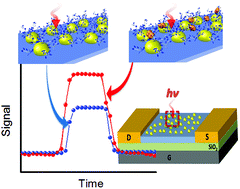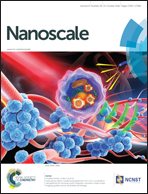Monitoring interfacial lectin binding with nanomolar sensitivity using a plasmon field effect transistor†
Abstract
By immobilizing glycopolymers onto the surface of the recently developed plasmonic field effect transistor (FET), the recognition between lectins and surface-immobilized glycopolymers can be detected over a wide dynamic range (10−10 to 10−4 M) in an environment that resembles the glycocalyx. The binding to the sensor surface by various lectins was tested, and the selectivities and relative binding affinity trends observed in solution were maintained on the sensor surface, and the significantly higher avidities are attributed to cluster-glycoside effects that occur on the surface. The combination of polymer surface chemistry and optoelectronic output in this device architecture produces amongst the highest reported detection sensitivity for ConA. This work demonstrates the benefits that arise from combining emerging device architectures and soft-matter systems to create cutting edge nanotechnologies that lend themselves to fundamental biological studies and integration into point-of-use diagnostics and sensors.


 Please wait while we load your content...
Please wait while we load your content...